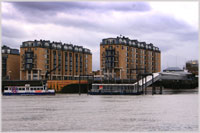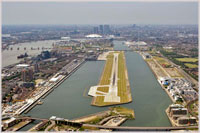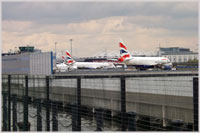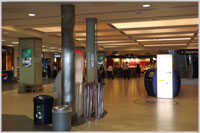LCA is the airport code for London City Airport. Your baggage tag will display it when you fly into this modern airport that emerged from a decaying dockyard from the last century.
In 1981, Mrs. Thatcher was the Prime Minister of Great Britain and had always kept her eye on the old enemy across the channel. President Francois Mitterand of France had ambitiously created a very spectacular redevelopment of the old La Defense district of Paris. He turned a derelict part of his Capital into a shiny, sparkling and brand new commercial centre. It was the perfect symbol of the new and enterprising spirit of the French nation getting itself ready for the twenty first century. Mrs. Thatcher was not going to be out done.
 The London Docklands Development Corporation was formed to convert the old, rusting, decaying and unused dockland district on the east side of London into somewhere equally impressive. It was a depressed district whose time had come and gone. It covered an area of 8.5 square miles in the London Boroughs of Newham, Tower Hamlets and Southwark and unemployment was high.
The London Docklands Development Corporation was formed to convert the old, rusting, decaying and unused dockland district on the east side of London into somewhere equally impressive. It was a depressed district whose time had come and gone. It covered an area of 8.5 square miles in the London Boroughs of Newham, Tower Hamlets and Southwark and unemployment was high.
The LDDC’s job was to create the towering and slightly intimidating new financial centre at Canary Wharf and the vast commercial installation of the Excel Centre. All of this new economic activity and business structure would be served by a brand new airport. The airport would nestle under the wing of this immense infrastructure providing access to Europe and ultimately beyond. The civil engineering and planning difficulties would be enormous.
There were two gigantic docks covering the planned site of the airport, the great King George V and the Royal Albert. The space between them was long enough for a runway. The surrounding support areas could provide sufficient space for the terminal building and car parking. The area was huge and would require great private investment in planning, equipment, heavy engineering machinery and man power. The civil engineering company, J Mowlam, began the creation process during the mid nineteen eighties.
 The architects needed to blend the brand new airport with the old dockyard symbols. The local politics with the borough councils was a tricky matter. The London Docklands were very much at the heart of the surrounding culture. Many local people had spent their working lives living and working in a district that actually had a very illustrious past. Planning applications had to be dealt with very carefully. Where possible, the designers preserved dockyard cranes, local listed building structures and other symbols representing a previous history. London City Airport was opened in 1987 and it became part of the renaissance of London’s old East End.
The architects needed to blend the brand new airport with the old dockyard symbols. The local politics with the borough councils was a tricky matter. The London Docklands were very much at the heart of the surrounding culture. Many local people had spent their working lives living and working in a district that actually had a very illustrious past. Planning applications had to be dealt with very carefully. Where possible, the designers preserved dockyard cranes, local listed building structures and other symbols representing a previous history. London City Airport was opened in 1987 and it became part of the renaissance of London’s old East End.
Initially, the airport had great limitations from a flying point of view. The runway distance was relatively short and the approach angle for landing aircraft had to be very steep. The planning authorities insisted on a steep approach to ensure noise levels in an urban area were kept as low as possible. Only two types of aircraft could be approved for such operations to begin with. The De Havilland Dash 7 was the primary contender. This was a four engine, turbine powered aircraft that could carry only 50 passengers at a relatively slow speed. Flying operations began with two companies competing on the London to Paris route. The airport would have to evolve before it could support itself commercially.
As the early years went by, the runway length was extended and approval, ultimately, was granted to reduce the approach angle. Other aircraft types of greater capacity and economy were able to use London City Airport. This made many other destinations in the UK and wider into Europe commercially viable. Nowadays, over 47 business and holiday destinations are served right across Europe. British Airways mainline also provides a First Class service to New York using Airbus aircraft. There are three scheduled services each day. The old dockyards are extremely busy once again linking London with the rest of the world just as they had always done in the past.
 For Londoners, the docklands airport is very easy to use. It lies about five miles from the city centre and is served well by the Docklands Light Railway from the very middle of the capital. Local busses and taxi services operate to the airport routinely. London City Airport today is as much a holiday airport as it is a provider of business travel. Over twelve prominent airlines operate from LCA including a British Airways regional airline, Air France, KLM, Lufthansa and Swissair. Executive air services are also provided from an exclusive, separate terminal at the western end of the complex.
For Londoners, the docklands airport is very easy to use. It lies about five miles from the city centre and is served well by the Docklands Light Railway from the very middle of the capital. Local busses and taxi services operate to the airport routinely. London City Airport today is as much a holiday airport as it is a provider of business travel. Over twelve prominent airlines operate from LCA including a British Airways regional airline, Air France, KLM, Lufthansa and Swissair. Executive air services are also provided from an exclusive, separate terminal at the western end of the complex.
The main terminal building has been developed and upgraded since its original construction. It provides every service including bars, restaurants, internet services and conference provision. The airport prides itself on a 15 minute check in time; it always has done. Today, the best known European airlines compete intensively for the very valuable landing rights at LCA. They operate with the most modern and efficient medium capacity jet airliners.
The decaying docklands area has been dramatically transformed into a new, twenty first century transportation system into Europe and much further. For the London traveller, whether on business or holiday, London City Airport is on the doorstep. It is simple and inexpensive to travel to, no vast distances to walk when you get there and a 15 minute check in time.
As you observe London from your window during the takeoff and landing, the view can be spectacular. Probably the very best panorama of London that can be seen from anywhere is on a clear day, arriving at London City Airport landing towards the east.
 London City Airport provides employment for about 2000 people, many of them still living in the new phoenix of the local area. It contributes much to the London economy and probably even more to the wider European economy from which we all benefit. The old, once decaying dockyards of the East End of London are again providing access to the world for us all. The routes nowadays travel across the sky, not the sea anymore.
London City Airport provides employment for about 2000 people, many of them still living in the new phoenix of the local area. It contributes much to the London economy and probably even more to the wider European economy from which we all benefit. The old, once decaying dockyards of the East End of London are again providing access to the world for us all. The routes nowadays travel across the sky, not the sea anymore.
There has been a suggestion from a government think tank that London City Airport should be closed. It concluded that the land would have much more value for building and industrial purposes. The think tank ignored how the structure and culture of the docklands has been transformed. It ignored how the local economy and quality of life for the local people has been re-born and dovetailed into the new century. I have a very soft spot for LCA as I used to work there. It gave me my particular passion for London life and I never stop admiring the glorious re-awakening of the old East End.











